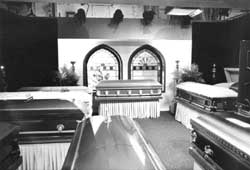 Faced with the loss of a loved one, whether expected or abrupt is not the issue. Most of us give into the familiar comfort offered by religion, culture and grief. We suspend planning and logic for the emotional cushion of the Grand Send Off. The notion of our mortality comes as a jolt. Rarely, if ever, are we considerate enough to pre-plan our own exit. This realisation set the Beed's mental cogs into a whirl, resulting in what some may label a rather morbid and tasteless column on the business of death.
Faced with the loss of a loved one, whether expected or abrupt is not the issue. Most of us give into the familiar comfort offered by religion, culture and grief. We suspend planning and logic for the emotional cushion of the Grand Send Off. The notion of our mortality comes as a jolt. Rarely, if ever, are we considerate enough to pre-plan our own exit. This realisation set the Beed's mental cogs into a whirl, resulting in what some may label a rather morbid and tasteless column on the business of death. Death is a perfectly respectable and well-conducted business in the United States. Many people have funeral plans. They put away a little something towards the ceremony, a burial spot or the increasingly popular route of ash to ash. The manager of a funeral home let on that funerals can cost $15,000-20,000-almost as much as most weddings.
Funeral homes have plenty of brochures that give detailed steps on how to plan your own funeral. It's a pragmatic approach that accepts all our bits and parts on the stage of life ends with curtains. It's all there, from how to write wills and structure accounts to reminders that the funeral home must be notified if there is a change in address. Unlike the esoteric rituals that surround funeral processes in Nepal, the Beed was pleasantly surprised by this method of soliciting customers-especially as every person is a future customer!
Following the tenets of good business practice, funeral homes have adapted to a changing American cultural landscape. Death has become a boom sector for private enterprises that work hard at personalising a business that ironically, requires detachment. They can and do cater to diverse religious communities. Many offer immigrants an informal rate inclusive of arrangements that allows them to incorporate elements of their own beliefs.
The Beed recently attended one of these funerals. The American-Hindu family was comfortable performing the last rites of the deceased from a funeral home. After all, adaptation is a two-way street. There was a sense of solace and peace to the proceedings as family members thanked those who came to pay their respects. There even was a small funeral procession to the crematorium behind the premises. The eldest placed an incense stick in lieu of the daag batti on the body as the large electric furnace was switched on. The ashes were placed in an urn and handed back to the family.
Altogether, very different from proceedings in Nepal. Besides the degradation of the environmant, far too many people find no comfort in the rites. A lot of them are milked into spending vast amounts on logs of sandalwood, gold, the gift of a cow.the list is endless and continuously embroidered upon. A complex web of socio-economic reasons bolster the attitude that "this is the way it's always been done". It keeps us from looking at our funeral rites with fresh eyes.
Kathmandu is bursting at the seams. While there have been talks about opening crematoriums, it needs more thought and planning. This initiative must come from religious groups. It is their duty to help Nepalis separate the rituals of death from the duties of the living.
We have embraced modern methods of birth. It's time to re-examine death.
Readers can post their comments or suggestions to [email protected]



